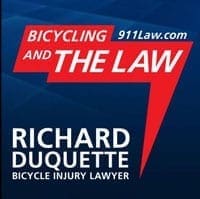By Richard Duquette, Esq, Law Firm of Richard Duquette
Listen to Podcast
This three-part series of articles focuses on imposing liability against state and local public entities in California. It does not address Federal liability, which is governed by the Federal Tort Claims Act. The intent is to generally explain how bicyclists can protect themselves in a variety of situations, including when they face pitfalls such as governmental immunity. Part one addresses general principles of government liability and the procedural requirements for filing a claim. Part two discusses the different types of government tort claims. Part three will discuss the various immunities to liability that governments enjoy.
Historically, public entities were immune from liability. This immunity was known as “sovereign immunity.” The idea behind this ancient doctrine was rooted in the divine right of kings, with the belief that when acting in his official capacity, “the king could do no wrong.” In the modern era this has changed. In 1963, the California Tort Claims Act (CTCA) was created by legislation. Following a trend set by the courts that immunity should be the exception rather than the rule, the CTCA essentially says there is no public entity immunity except when allowed by statute. Part two of this series will address the situations where liability is imposed by statute, while part three will address the situations where immunity is the rule. The remainder of this installment will outline the procedural pitfalls involved in bringing such a claim.
Procedure
So, assuming you have a meritorious case against a government entity and sovereign immunity does not apply, what happens next? There are a number of things you need to be aware of that make these cases procedurally more challenging than a case against a private entity.
First is the issue of place. Unlike when suing a private company or individual, you cannot just go straight to court. At this stage in the process, the claim is an administrative one, not a judicial one. You have to first file a written notice of claim with the government entity you intend to sue (Gov. Code §910). Most public entities have their own form available online to streamline this process. These forms must contain relevant information and the factual basis for your claim. So in addition to filling them out properly, you should attach a copy of the police report, pictures, and proof of your damages in order to comply. If you do not know which public entity owns the land, you should file a claim with each entity that may possibly own it. You may not know whether the land you were injured upon belongs to the state, the city, or the county. In that case, file with all three. The agencies that do not own or control the property will send notice. San Diego County provides its claim form here, as an example of how the process works in practice. In some cases you will want to make sure not only that you have the right vertical entity (state, county, city), but also the right horizontal entity. For instance, depending on your injury your claim may be against the local park district or the local transit district.
Second, and equally important, is the issue of timing. Public entity claims have an accelerated statute of limitations. The typical personal injury case has a statute of limitations of two years, meaning that you have two years after the injury to file a lawsuit, after which your claim will be barred (Code of Civil Procedure §335.1). But with government claims, you have only six months to file the government claim form required to comply with the administrative process outlined above (Gov. Code §911.2).
After this, the relevant entity will either admit liability or reject your claim. The public entity has forty-five (45) days to respond (Gov. Code §912.4). Failure to respond within this time is deemed a rejection, although it has a different effect. If your claim is formally rejected by written notice, you have six months to file suit, measured from the day written rejection of the claim was delivered (Gov. Code §§913, 945.6). If written notice of rejection is not given, though the claim is still rejected, you have two years from the date of the injury to file suit, as with an ordinary personal injury claim (Gov. Code §945.6(a)(2)).
Finally, once you get to court, there are additional pitfalls. Remember that there are always a few built-in disadvantages to plaintiffs litigating against the government. First, even in cases where sovereign immunity doesn’t apply, plaintiffs still cannot recover punitive damages against government agencies. This is because the deterrent rationale of punitive damages is not believed to apply to such cases. Second, the risk of ending up before a jury of taxpayers who are biased against such claims is significant. Moreover, if you do lose, the government will seek to recover their costs against you, which could include liening your home equity.
The above is a summary of the procedural hazards plaintiffs face when they try to assert a claim against a government entity. These pitfalls are precisely why it is important that you get a wise and experienced attorney to help you with your claim, so you don’t lose an otherwise winnable case. Contact the Law Firm of Richard Duquette for assistance with your case.
Read Part 2 – Bicyclists’ Rights Against Public Entities: Potholes to Trails Part 2 – Potholes and Government Land
Read Part 3 – Bicyclists’ Rights Against Public Entities: Potholes to Trails Part 3 – Immunities Shield
Enjoy More Articles and Podcasts By Richard Duquette, Esq, Law Firm of Richard Duquette
About the Law Firm of Richard L. Duquette
The Law Firm of Richard Duquette has recovered millions in damages for injured bicyclists since 1983. Attorney Duquette is an experienced bicyclist himself and has dedicated his practice to helping this community. He is experienced in all types of cases involving bicycle crashes, injuries, and other legal troubles.
Mr. Duquette serves a wide variety of bicyclists. Whether you prefer road cycling, mountain biking, track riding, Randonneuring, E-Bicycles, Handcycles, Century Rides, Triathlons, Duathlons, or Criterium, Mr. Duquette knows how to best serve your legal needs regardless of the type of bicyclist you are.
Mr. Duquette is an expert at maximizing, proving, and recovering damages.
For more information please visit the Law Firm of Richard Duquette.
The information in this article is for general information purposes only. The focus of this article is on California Law. You should contact an attorney in your state for case-specific advice, as details of the law and procedural requirements vary from state to state. Nothing in this article should be taken as legal advice for any individual case or situation. This information is not intended to create an attorney-client relationship; and the receipt, reading, listening, or viewing of this content shall not constitute an attorney-client relationship. Nothing in this article shall be construed as a warrant, promise, or guarantee about the outcome of your case or any other matter. This information may contain personal impressions or statements of opinion on a subject that do not apply in your case. Further, statements of law reflect the current state of the law at the time of writing and/or recording, and may not reflect subsequent changes in the law.
No products found.


















